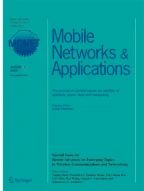Abstract
Power consumption is a critical issue in many wireless sensor network scenarios where network life expectancy is measured in months or years. Communication protocols typically rely on synchronous operation and duty-cycle mechanisms to reduce the power usage at the cost of decreased network responsiveness and increased communication latency. A low-power radio-triggered device can be used to continuously monitor the channel and activate the node for incoming communications, allowing purely asynchronous operations. To be effective, the power consumption of this wake-up device must be on the order of tens of microwatts since this device is always active. This paper presents our first attempt at designing such a low-power receiver. Very few realizations of wake-up devices are reported in the literature and none presents power dissipation below 40 μW. Our design implements a complete wake-up device and initial results indicate an average power consumption below 20 μW, which is more than 2 times lower than other reported devices.











Similar content being viewed by others
Notes
Gaussian noise is used here to approximate the addition of Rayleigh-distributed noise, due to envelope detection, and input referred electronic noise. The average of the Rayleigh distribution is suppressed by the AC-coupling at the input of the amplifier. Furthermore, experimental measures validate this approximation.
Abbreviations
- ASK:
-
amplitude shift keying
- BF:
-
beamforming
- BFN:
-
beamforming network
- ISM:
-
industrial, scientific and medical
- OOK:
-
on-off keying
- PWM:
-
pulse-width modulation
- SNR:
-
signal to noise ratio
- RF:
-
radio frequency
- WSN:
-
wireless sensor network
- WUR:
-
wake-up radio
References
Texas Instrument, C.C. 2420 2.4 GHz IEEE 802.15.4/ZigBee-ready RF Transceiver datasheet, http://focus.ti.com/lit/ds/symlink/cc2420.pdf. Accessed 23 December 2008
Karl H, Willig A (2005) Protocols and architectures for wireless sensor networks. Wiley, Chichester
Lin E-Y, Rabaey J, Wolisz A (2004) Power-efficient rendez-vous schemes for dense wireless sensor networks, doi:10.1109/ICC.2004.1313259
Pletcher N, Gambini S, Rabaey J (2008) A 2 GHz 52 μW Wake-up receiver with -72dBm sensitivity using uncertain-IF architecture, doi:10.1109/ISSCC.2008.4523288
Pletcher N, Gambini S, Rabaey J (2007) A 65 μW, 1.9 GHz RF to digital baseband wakeup receiver for wireless sensor nodes, doi:10.1109/CICC.2007.4405789
von der Mark S, Boeck G (2007) Ultra low power wakeup detector for sensor networks, doi:10.1109/IMOC.2007.4404394
van der Doorn B, Kavelaars W, Langendoen K. A prototype low-cost wakeup radio for the 868 MHz Band, doi:10.1504/IJSNET.2009.023313
Kolinko P, Larson LE (2007) Passive RF receiver design for wireless sensor networks, doi:10.1109/MWSYM.2007.380553
Ansari J, Pankin D, Mahonen P (2008) Radio-triggered wake-ups with addressing capabilities for extremely low power sensor network applications, doi:10.1109/PIMRC.2008.4699501
Gu L, Stankovic JA (2004) Radio-triggered wake-up capability for sensor networks, doi:10.1109/RTTAS.2004.1317246
Kuan-Yu L, Tsang TKK, Sawan M, El-Gamal MN (2006) Radio-triggered solar and RF power scavenging and management for ultra low power wireless medical applications, doi:10.1109/ISCAS.2006.1693936
Black HS (1953) Modulation theory. Van Nostrand, New York
Carlson AB (2002) Communication systems, 4th edn. McGraw-Hill, New-York
Ramanathan R (2001) On the performance of ad hoc networks with beamforming antennas, doi:10.1145/501426.501430
Choudhury RR, Yang X, Ramanathan R, Vaidya NH (2006) On designing MAC protocols for wireless networks using directional antennas, doi:10.1109/TMC.2006.69
Huang R, Manoli Y (2004) Phased array and adaptive antenna transceivers in wireless sensor networks, doi:10.1109/DSD.2004.1333329
Author information
Authors and Affiliations
Corresponding author
Additional information
This work is supported in part by the Fonds Québécois de la Recherche sur la Nature et les Technologies (FQRNT) and by the Mycrosystems Strategic Alliance of Quebec (ReSMiQ). This paper was originally presented at the 4th IEEE international conference on Wireless and Mobile Computing, Networking and Communications (WiMob 2008).
Rights and permissions
About this article
Cite this article
Le-Huy, P., Roy, S. Low-Power Wake-Up Radio for Wireless Sensor Networks. Mobile Netw Appl 15, 226–236 (2010). https://doi.org/10.1007/s11036-009-0184-3
Published:
Issue Date:
DOI: https://doi.org/10.1007/s11036-009-0184-3
